When the common individual hears “trout,” they most likely take into consideration a generic fish; however when an angler hears “trout,” they suppose “what type!?” North America is house to many several types of trout, and it’s necessary to know the place these species are discovered earlier than you set out for a fishing journey. It’s additionally extraordinarily necessary to have the ability to inform them aside as a result of completely different species have completely different take limits all year long.
Right here, we’ll go over the species and a number of the main subspecies and hybrids present in North America. Understanding some fundamentals about trout species, the place they are often discovered, and what their life histories are like will help you turn into a greater angler. The extra you perceive in regards to the fish, the simpler will probably be to decide on the place and when to fish.
Fast Navigation:
Native Vs Invasive | Ecotypes | Native Trout | Hybrid Trout | Char
Trout Species Listed:
Cutthroat | Gila & Apache | Golden | Rainbow | Redband | Brown | Cutbow | Splake | Tiger | Brook | Bull | Dolly Varden | Lake
Most trout species current in North America are native species, however some are launched and even invasive. An launched species is any nonnative species that has been built-in into the native setting. An invasive species is an launched species that has turn into detrimental to the native setting.
Rainbow trout are infamous for his or her position as an invasive species all through the world. This contains elements of North America— rainbow trout might be present in practically each state, however are solely native to the western coast of the continent. In some areas, rainbow trout threaten different species populations.
That mentioned, launched and invasive species don’t simply create issues; they’ll clear up issues, relying on how folks handle them. Within the case of trout, launched species can displace them in pure spawning conditions, however they’ll additionally scale back human strain on the native populations by offering one other species to fish for.
Conservation will also be a purpose to introduce a species. For instance, the Eagle Lake trout was considered extinct till 1958, when a inhabitants was rediscovered. Folks instantly started to breed them and reintroduce them to Eagle Lake, in addition to lakes within the surrounding watershed. This meant that if the primary inhabitants suffered a crash or illness, the encircling waters would nonetheless have wholesome fish to assist rebuild the inhabitants. Due to this introduction, the species persists to today.
Trout are extremely adaptable fish, and their populations fall into categorizations known as ecotypes. An ecotype is a definite type of a species that has tailored to native ecological situations. For trout, the three attainable ecotypes are lacustrine, riverine, and anadromous. Understanding what ecotype the native trout have will enable you select one of the best time for fishing.
These species are true North American trout (members of the genus Oncorhynchus). Salmo is one other genus of true trout, nevertheless it isn’t native to North America. These species are additionally generally known as Pacific trout, regardless that their distribution isn’t restricted to the Pacific Coast.
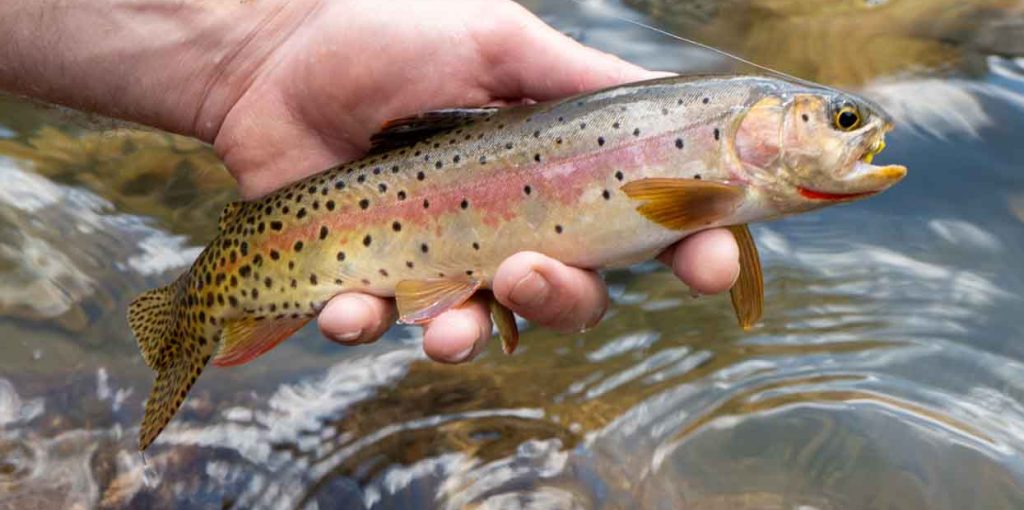
Cutthroat Trout
The cutthroat trout (Oncorhynchus clarki) is a popular gamefish with a complicated taxonomy. There are as many as fifteen subspecies, primarily divided by geographic location. Here, we’ll be discussing the main species, since you’ll usually only find one kind of cutthroat in any particular stream or lake.
The cutthroat trout can be green, olive, brown, or golden in color with red, pink, or orange gill plates. Cutthroat trout have two slashes of red under their gills, which is what gives them their name. Their back and sides are lightly spotted, with heavier spotting on their fins. It is worth noting, sometimes the slashes under the gill plates can be hard to see or non existent in some bodies of water.
The Gila (Oncorhynchus gilae) and Apache (Oncorhynchus apache) trout are a pair of associated species native to the southwestern United States. Each of those trout are endangered and have solely just lately been reopened to sport fishing.
Gila trout vary from yellow to copper-colored, with quite a few small, darkish spots above the lateral line. Apache trout are often a brighter yellow with giant physique spots. Additionally they sometimes have two darkish spots of their eyes on all sides of the pupil, resembling a stripe going by way of their eyes.
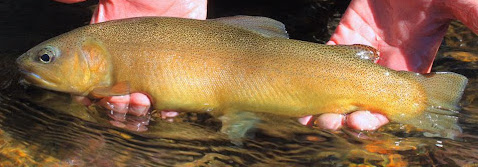
Gila Trout
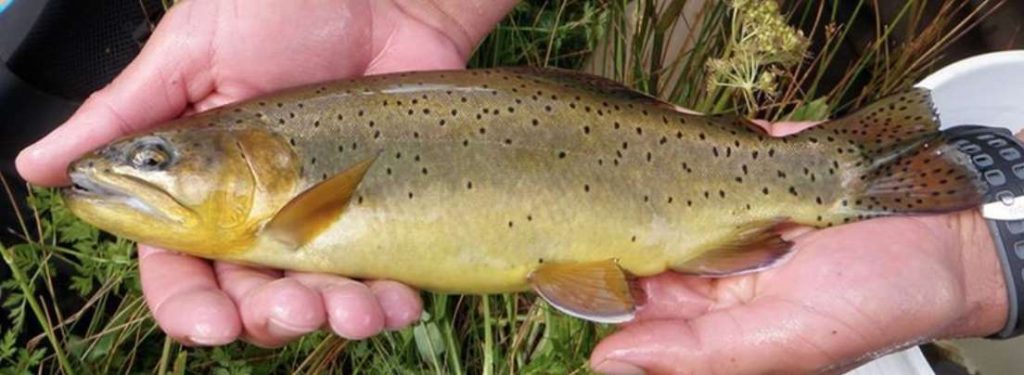
Apache Trout

California Golden Trout
The golden trout (Oncorhynchus aguabonita) is taken into account a subspecies of rainbow trout by some scientists and a separate species by others. The state of California considers it the official state freshwater fish! This trout has golden flanks with a reddish band alongside the lateral strains. There are additionally often 10 darkish, oval parr marks on all sides. The fins have white edges. It is a smaller species of trout, particularly in its riverine kind.
Oncorhynchus aguabonita is to not be confused with the golden rainbow trout, or palomino trout. That trout is a colour morph of the common rainbow trout with a yellow background as a substitute of a silvery background.
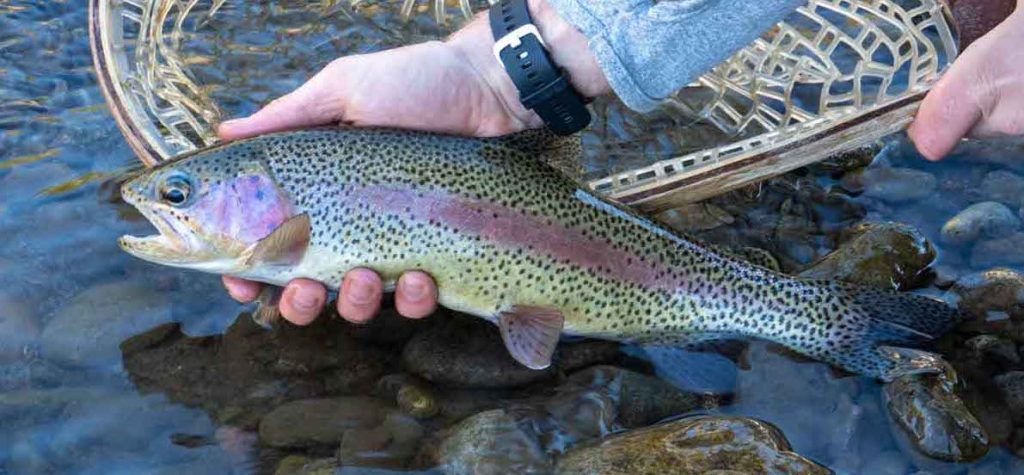
Feminine Rainbow Trout
The rainbow trout, Oncorhynchus mykiss, is likely one of the commonest trout on the earth. It has been launched practically in every single place and has dozens of subspecies. To maintain issues easy, we’re going to speak about crucial subspecies (the redband trout) individually from this principal overview of the rainbow trout.
The rainbow trout is often olive inexperienced on the again, with silvery flanks and a pink or purple stripe alongside the physique. They’ve small black spots over most of their physique, together with their fins and tail, and their purple colour intensifies throughout spawning season.
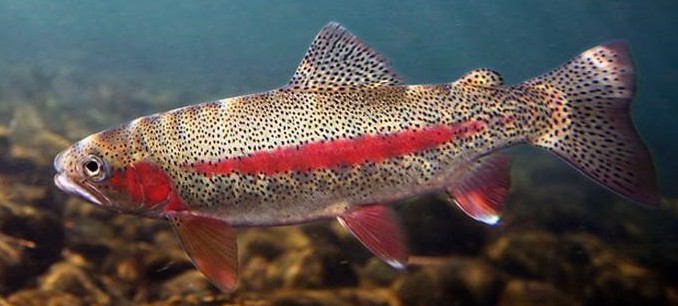
Redband Trout
Redband trout are a posh of a number of rainbow trout subspecies. They embrace the Columbia River redband trout (O. m. gairdneri), the McCloud River redband trout (O. m. stonei), and the Nice Basin redband trout (O. m. newberrii). These are the three principal sorts of redband trout; nevertheless, there are some subspecies which are genetically distinct and have restricted ranges. One in every of these is the Eagle Lake trout (O. m. aquilarum), which is simply indigenous to Eagle Lake in California. One other is the Kamloops trout (O. m. kamloops), which is present in a number of giant British Columbia lakes, most notably Kamloops Lake and Kootenay Lake.
Redband trout typically look much like rainbow trout, however have bigger, rounded spots and parr marks that have a tendency to stay into maturity. They’ve a band of intense orange-red colour across the lateral line and their fins have distinctive white suggestions. Redband trout that dwell in small streams are often 6-10 inches lengthy at maturity, however redband trout in larger rivers shall be on common 14-30 inches lengthy.
Word: On this case, by “invasive”, we actually imply non native.
There is just one invasive non-North American trout species, the brown trout. Whereas some species of trout are domestically invasive, these are species which have been translocated from different North American fisheries. Lots of the non-scientific neighborhood wouldn’t think about brown trout an invasive species since it’s so frequent throughout the U.S. and nonetheless closely stocked in lots of areas.
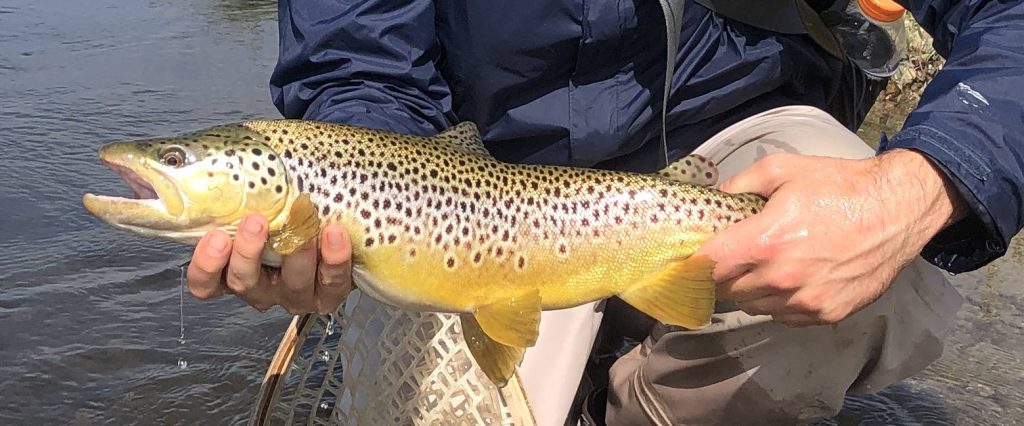
Brown Trout
The brown trout, Salmo trutta, is a European species that has been stocked in virtually every US state. Brown trout have a background color ranging from olive green to brown which fades to a creamy off-white along the belly. They have black spots all over their sides, back, and dorsal fin, but not on their tails. The spots near their lateral lines are often red, and most of their body spots will have a halo of light pigment.
Hybrid trout species are blends of two different trout species. They usually exhibit traits of each mum or dad species. Some are naturally occurring; others are solely discovered bred by fisheries.

Cutbow Trout
The cutbow trout is a hybrid of the cutthroat and rainbow trout. This hybrid can be found in waters with both of the parent species, and identifying them can be difficult. We go into detail about how to tell them apart here, but generally what to look for is white-tipped fins (a rainbow trait) on a fish with a vivid red, orange, or pink gill plate (a cutthroat trait). If it’s not quite a cutthroat and not quite a rainbow, it’s probably a cutbow!
Cutbows are genetically stable and able to reproduce. They can occur naturally, or can be bred and stocked by fisheries. Usually it comes into existence when one of the parent species is stocked in waters containing the other.
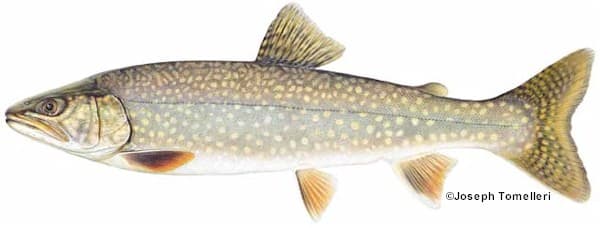
Splake Trout Illustration By Joseph Tomelleri
Splake are a hybrid of a male brook trout and a feminine lake trout. Like cutbows, splake are genetically steady and will hypothetically reproduce; nevertheless, they don’t exhibit suitable breeding conduct and are solely identified to have restricted replica in 5 lakes.
Splake look nearly similar to brook trout in terms of colour. To inform them aside, take a look at the tails. Splake have a shallowly forked tail, whereas brook trout have squared tails with no fork.

Tiger Trout
The tiger trout is a sterile hybrid of the brown trout and brook trout. This hybrid is vividly coloured, with darkish striations on a golden or orange background, giving it its identify. Whereas this hybrid can sometimes be produced naturally, it’s thought of completely launched as a result of one of many mum or dad species is a nonnative species.
Some species are generally known as trout, however are literally not true trout! These fish all look much like trout, however additional research has proven that they’re a separate genus, Salvelinus.
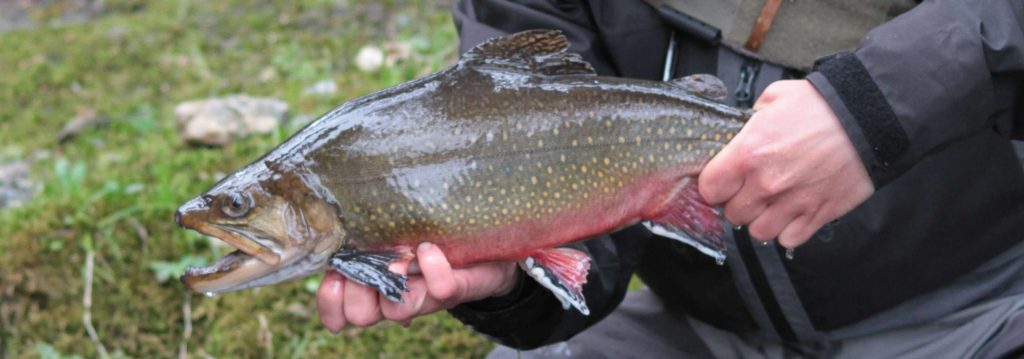
Brook Trout
Brook trout (Salvelinus fontinalis) are a widely-distributed species of fish that are present throughout most of North America. Unlike other char and trout species, these fish do not have a forked tail. They are usually dark green or brown, and have a light marbled pattern on their sides and back. They have red spots with blue halos on their sides. Their bellies are reddish, and their lower fins are red with white edges.
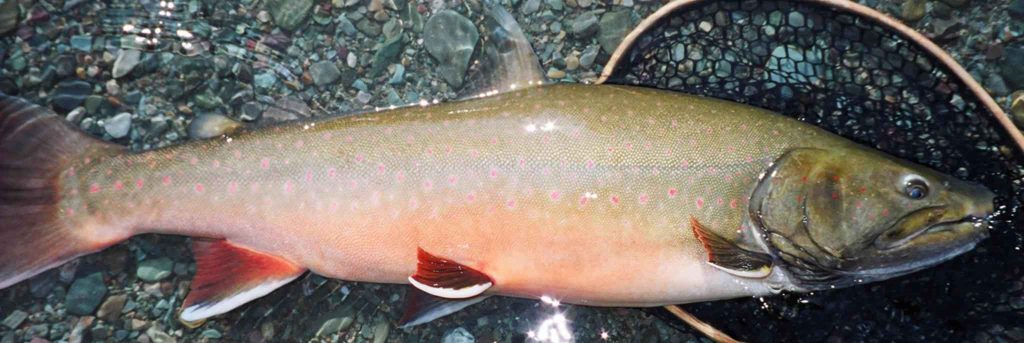
Bull Trout
The bull trout (Salvelinus confluentus) has a big head and mouth, from which its identify derives. Whereas this species will dwell in rivers and lakes, it has a powerful migration drive and can spawn in rivers once they dwell in lakes. This species might be rapidly recognized by the dearth of black pigmentation in or round its orange or yellow spots and the white forefront of its decrease fins. The dorsal fin is unspotted, which is helpful for differentiation from brook trout.
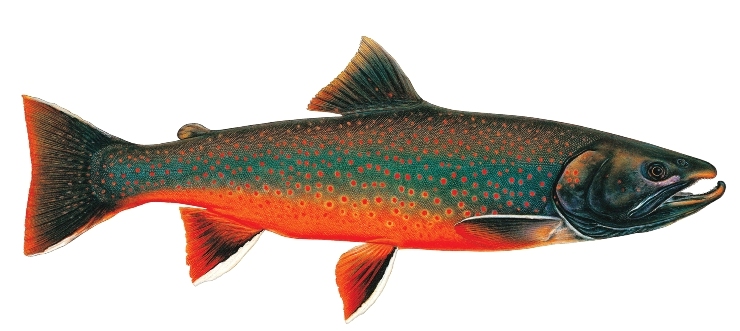
Dolly Varden
The Dolly Varden trout (Salvelinus malma) bought its identify from a Dickens character identified for her vibrant purple gown. True to their namesake, these fish have good purple or orange spots on a darkish gray, brown, or olive background. Native to Alaskan waters, the Dolly Varden trout has been launched in a number of areas within the western US, however none of those populations has been self-sustaining.
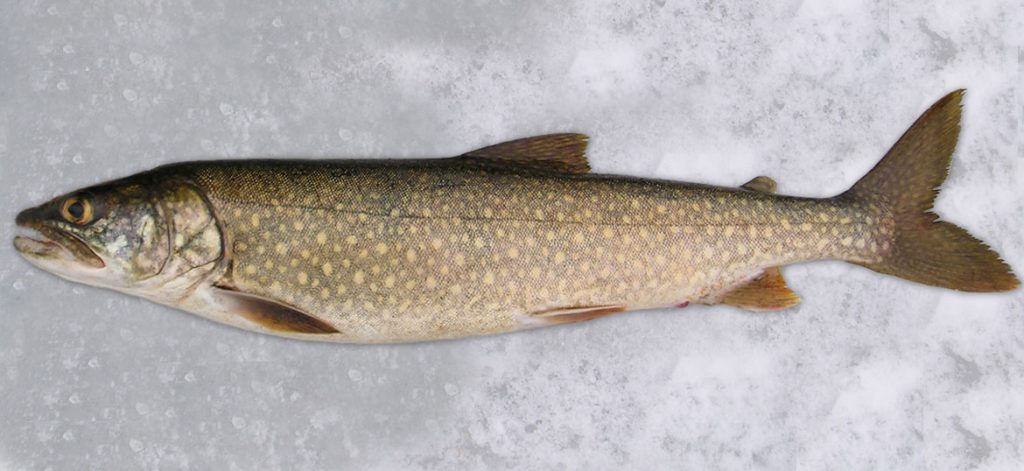
Lake Trout
Lake trout (Salvelinus namaycush) are a big fish discovered primarily in chilly, deep lakes, generally at depths of as much as 200 ft. They’re identifiable by their giant, rounded heads, deeply forked tails, and lightweight spots on a darkish inexperienced to gray physique.
The entire North American trout species are enjoyable, difficult initiatives for the fly angler. As long as there’s cool, clear water, there’s more likely to be trout close by. Whereas luring these unimaginable predators may be a problem, understanding extra about them will help you get the higher hand.

Max DesMarais
Max DesMarais is the founding father of hikingandfishing.com. He has a ardour for the outside and making out of doors schooling and journey extra accessible. Max is a broadcast creator for varied out of doors journey, journey, and advertising and marketing web sites. He’s an skilled hiker, backpacker, fly fisherman, path runner, and spends his free time within the outdoor. These adventures permit him to check gear, be taught new expertise, and expertise new locations in order that he can educate others. Max grew up mountain climbing throughout New Hampshire and New England. He grew to become obsessive about the New Hampshire mountains, and the NH 48, the place he guided hikes and path runs within the White Mountains. Since transferring out west, Max has continued his frequent adventures within the mountains, at all times testing gear, studying expertise, gaining expertise, and constructing his endurance for out of doors sports activities. You may learn extra about his expertise right here: hikingandfishing/about
Right here, we’ll go over the species and a number of the main subspecies and hybrids present in North America. Understanding some fundamentals about trout species, the place they are often discovered, and what their life histories are like will help you turn into a greater angler. The extra you perceive in regards to the fish, the simpler will probably be to decide on the place and when to fish.
Fast Navigation:
Native Vs Invasive | Ecotypes | Native Trout | Hybrid Trout | Char
Trout Species Listed:
Cutthroat | Gila & Apache | Golden | Rainbow | Redband | Brown | Cutbow | Splake | Tiger | Brook | Bull | Dolly Varden | Lake
Native vs. Launched vs. Invasive Species: What’s the Distinction?
Most trout species current in North America are native species, however some are launched and even invasive. An launched species is any nonnative species that has been built-in into the native setting. An invasive species is an launched species that has turn into detrimental to the native setting.
Rainbow trout are infamous for his or her position as an invasive species all through the world. This contains elements of North America— rainbow trout might be present in practically each state, however are solely native to the western coast of the continent. In some areas, rainbow trout threaten different species populations.
That mentioned, launched and invasive species don’t simply create issues; they’ll clear up issues, relying on how folks handle them. Within the case of trout, launched species can displace them in pure spawning conditions, however they’ll additionally scale back human strain on the native populations by offering one other species to fish for.
Conservation will also be a purpose to introduce a species. For instance, the Eagle Lake trout was considered extinct till 1958, when a inhabitants was rediscovered. Folks instantly started to breed them and reintroduce them to Eagle Lake, in addition to lakes within the surrounding watershed. This meant that if the primary inhabitants suffered a crash or illness, the encircling waters would nonetheless have wholesome fish to assist rebuild the inhabitants. Due to this introduction, the species persists to today.
Trout Ecotypes
Trout are extremely adaptable fish, and their populations fall into categorizations known as ecotypes. An ecotype is a definite type of a species that has tailored to native ecological situations. For trout, the three attainable ecotypes are lacustrine, riverine, and anadromous. Understanding what ecotype the native trout have will enable you select one of the best time for fishing.
- Lacustrine trout dwell in lakes, however generally migrate to rivers to spawn
- Riverine trout spend their entire lives in rivers and are sometimes smaller than their lacustrine cousins, relying on the dimensions of their stream
- Anadromous trout are born in rivers, migrate to the ocean, after which return to the river to spawn throughout an annual “run”
Native Trout Species
These species are true North American trout (members of the genus Oncorhynchus). Salmo is one other genus of true trout, nevertheless it isn’t native to North America. These species are additionally generally known as Pacific trout, regardless that their distribution isn’t restricted to the Pacific Coast.
Cutthroat Trout

Cutthroat Trout
The cutthroat trout (Oncorhynchus clarki) is a popular gamefish with a complicated taxonomy. There are as many as fifteen subspecies, primarily divided by geographic location. Here, we’ll be discussing the main species, since you’ll usually only find one kind of cutthroat in any particular stream or lake.
The cutthroat trout can be green, olive, brown, or golden in color with red, pink, or orange gill plates. Cutthroat trout have two slashes of red under their gills, which is what gives them their name. Their back and sides are lightly spotted, with heavier spotting on their fins. It is worth noting, sometimes the slashes under the gill plates can be hard to see or non existent in some bodies of water.
| Species Name | Common Name | Range | Ecotypes |
| Oncorhynchus clarki | Cutthroat Trout | Western North America; introduced in limited eastern and southeastern US locations | Lacustrine, Riverine, Anadromous (rarely) |
| Average size | Maximum size | Spawning Season | USFWS Species Information |
| 6-36 inches (depends on habitat, food availability, and subspecies) | 39 inches | December-June | Cutthroat Trout |
Gila/Apache Trout
The Gila (Oncorhynchus gilae) and Apache (Oncorhynchus apache) trout are a pair of associated species native to the southwestern United States. Each of those trout are endangered and have solely just lately been reopened to sport fishing.
Gila trout vary from yellow to copper-colored, with quite a few small, darkish spots above the lateral line. Apache trout are often a brighter yellow with giant physique spots. Additionally they sometimes have two darkish spots of their eyes on all sides of the pupil, resembling a stripe going by way of their eyes.

Gila Trout
| Species Identify | Frequent Identify | Vary | Ecotypes |
| Oncorhynchus gilae | Gila Trout | Arizona and New Mexico | Riverine |
| Common dimension | Most dimension | Spawning Season | USFWS Species Data |
| 10-12 inches | 22 inches | March-July | Gila Trout |

Apache Trout
| Species Identify | Frequent Identify | Vary | Ecotypes |
| Oncorhynchus apache | Apache Trout | Arizona | Riverine |
| Common dimension | Most dimension | Spawning Season | USFWS Species Data |
| 9-10 inches | 23 inches | March-June | Apache Trout |
Golden Trout

California Golden Trout
The golden trout (Oncorhynchus aguabonita) is taken into account a subspecies of rainbow trout by some scientists and a separate species by others. The state of California considers it the official state freshwater fish! This trout has golden flanks with a reddish band alongside the lateral strains. There are additionally often 10 darkish, oval parr marks on all sides. The fins have white edges. It is a smaller species of trout, particularly in its riverine kind.
Oncorhynchus aguabonita is to not be confused with the golden rainbow trout, or palomino trout. That trout is a colour morph of the common rainbow trout with a yellow background as a substitute of a silvery background.
| Species Identify | Frequent Identify | Vary | Ecotypes |
| Oncorhynchus aguabonita | Golden Trout | Native to the southern Sierra Madres; launched within the western/southwestern US | Lacustrine, Riverine |
| Common dimension | Most dimension | Spawning Season | Sierra Forest Legacy Species Data |
| 6-10 inches in native vary; 12+ inches in launched lakes | 28 inches | Late June-July | Golden Trout |
Rainbow Trout

Feminine Rainbow Trout
The rainbow trout, Oncorhynchus mykiss, is likely one of the commonest trout on the earth. It has been launched practically in every single place and has dozens of subspecies. To maintain issues easy, we’re going to speak about crucial subspecies (the redband trout) individually from this principal overview of the rainbow trout.
The rainbow trout is often olive inexperienced on the again, with silvery flanks and a pink or purple stripe alongside the physique. They’ve small black spots over most of their physique, together with their fins and tail, and their purple colour intensifies throughout spawning season.
| Species Identify | Frequent Identify | Vary | Ecotypes |
| Oncorhynchus mykiss | Rainbow Trout, Steelhead Trout (coastal variants) | Western North America, western Russia; launched practically in every single place the place temperatures are appropriate | Lacustrine, Riverine, Anadromous |
| Common dimension | Most dimension | Spawning Season | USFWS Species Data |
| 20-30 inches | 45 inches | February-Could | Rainbow Trout |
Redband Trout

Redband Trout
Redband trout are a posh of a number of rainbow trout subspecies. They embrace the Columbia River redband trout (O. m. gairdneri), the McCloud River redband trout (O. m. stonei), and the Nice Basin redband trout (O. m. newberrii). These are the three principal sorts of redband trout; nevertheless, there are some subspecies which are genetically distinct and have restricted ranges. One in every of these is the Eagle Lake trout (O. m. aquilarum), which is simply indigenous to Eagle Lake in California. One other is the Kamloops trout (O. m. kamloops), which is present in a number of giant British Columbia lakes, most notably Kamloops Lake and Kootenay Lake.
Redband trout typically look much like rainbow trout, however have bigger, rounded spots and parr marks that have a tendency to stay into maturity. They’ve a band of intense orange-red colour across the lateral line and their fins have distinctive white suggestions. Redband trout that dwell in small streams are often 6-10 inches lengthy at maturity, however redband trout in larger rivers shall be on common 14-30 inches lengthy.
| Species Identify | Frequent Identify | Vary | Ecotypes |
| Oncorhynchus mykiss spp. | Redband Trout | Western North America (California, Idaho, Montana, Oregon, Utah, Washington, British Columbia) | Lacustrine, Riverine, Anadromous |
| Common dimension | Most dimension | Spawning Season | USFWS Species Data |
| 10-30 inches | 41 inches | December-August, primarily based on temperature | Redband Trout |
Invasive Trout Species
Word: On this case, by “invasive”, we actually imply non native.
There is just one invasive non-North American trout species, the brown trout. Whereas some species of trout are domestically invasive, these are species which have been translocated from different North American fisheries. Lots of the non-scientific neighborhood wouldn’t think about brown trout an invasive species since it’s so frequent throughout the U.S. and nonetheless closely stocked in lots of areas.
Brown Trout

Brown Trout
The brown trout, Salmo trutta, is a European species that has been stocked in virtually every US state. Brown trout have a background color ranging from olive green to brown which fades to a creamy off-white along the belly. They have black spots all over their sides, back, and dorsal fin, but not on their tails. The spots near their lateral lines are often red, and most of their body spots will have a halo of light pigment.
| Species Name | Common Name | Range | Ecotypes |
| Salmo trutta | Brown Trout | All US states except Alaska, Florida, Hawaii, Louisiana, and Mississippi | Lacustrine, Riverine, Anadromous |
| Average size | Maximum size | Spawning Season | US FWS Species Information |
| 12-14 inches | 39 inches | October-December | Brown Trout |
Hybrid Trout Species
Hybrid trout species are blends of two different trout species. They usually exhibit traits of each mum or dad species. Some are naturally occurring; others are solely discovered bred by fisheries.
Cutbow Trout

Cutbow Trout
The cutbow trout is a hybrid of the cutthroat and rainbow trout. This hybrid can be found in waters with both of the parent species, and identifying them can be difficult. We go into detail about how to tell them apart here, but generally what to look for is white-tipped fins (a rainbow trait) on a fish with a vivid red, orange, or pink gill plate (a cutthroat trait). If it’s not quite a cutthroat and not quite a rainbow, it’s probably a cutbow!
Cutbows are genetically stable and able to reproduce. They can occur naturally, or can be bred and stocked by fisheries. Usually it comes into existence when one of the parent species is stocked in waters containing the other.
| Species Name | Common Name | Range | Ecotypes |
| O. clarki x O. mykiss | Cutbow Trout | Western US and Canada, wherever cutthroats and rainbows overlap through stocking | Lacustrine, Riverine, Anadromous |
| Average size | Maximum size | Spawning Season | USGS Species Information |
| 15-20 inches | 45 inches | February-May | Cutbow Trout |
Splake

Splake Trout Illustration By Joseph Tomelleri
Splake are a hybrid of a male brook trout and a feminine lake trout. Like cutbows, splake are genetically steady and will hypothetically reproduce; nevertheless, they don’t exhibit suitable breeding conduct and are solely identified to have restricted replica in 5 lakes.
Splake look nearly similar to brook trout in terms of colour. To inform them aside, take a look at the tails. Splake have a shallowly forked tail, whereas brook trout have squared tails with no fork.
| Species Identify | Frequent Identify | Vary | Ecotypes |
| S. namaycush X S. fontinalis | Splake | Launched all through the US | N/A; hatchery-grown solely |
| Common dimension | Most dimension | Spawning Season | USGS Species Data |
| 10-18 inches | 35 inches | None | Splake |
Tiger Trout

Tiger Trout
The tiger trout is a sterile hybrid of the brown trout and brook trout. This hybrid is vividly coloured, with darkish striations on a golden or orange background, giving it its identify. Whereas this hybrid can sometimes be produced naturally, it’s thought of completely launched as a result of one of many mum or dad species is a nonnative species.
| Species Identify | Frequent Identify | Vary | Ecotypes |
| S. fontinalis X S. trutta | Tiger trout | Launched to the Nice Lakes area and western US | None; launched solely |
| Common dimension | Most dimension | Spawning Season | USGS Species Data |
| 10-16 inches | 20 inches | None | Tiger Trout |
Char (NOT Trout)
Some species are generally known as trout, however are literally not true trout! These fish all look much like trout, however additional research has proven that they’re a separate genus, Salvelinus.
Brook Trout

Brook Trout
Brook trout (Salvelinus fontinalis) are a widely-distributed species of fish that are present throughout most of North America. Unlike other char and trout species, these fish do not have a forked tail. They are usually dark green or brown, and have a light marbled pattern on their sides and back. They have red spots with blue halos on their sides. Their bellies are reddish, and their lower fins are red with white edges.
| Species Name | Common Name | Range | Ecotypes |
| Salvelinus fontinalis | Brook Trout (sometimes Speckled Trout) | Canada and the northern US; present in all US states except Florida, Hawaii, Louisiana, Mississippi, and Oklahoma | Lacustrine, Riverine |
| Average size | Maximum size | Spawning Season | US FWS Species Information |
| 10-11 inches | 34 inches | September-October | Brook Trout |
Bull Trout

Bull Trout
The bull trout (Salvelinus confluentus) has a big head and mouth, from which its identify derives. Whereas this species will dwell in rivers and lakes, it has a powerful migration drive and can spawn in rivers once they dwell in lakes. This species might be rapidly recognized by the dearth of black pigmentation in or round its orange or yellow spots and the white forefront of its decrease fins. The dorsal fin is unspotted, which is helpful for differentiation from brook trout.
| Species Identify | Frequent Identify | Vary | Ecotypes |
| Salvelinus confluentus | Bull trout | Northwestern US (California, Idaho, Montana, Nevada, Oregon, Washington), northwestern Canada | Lacustrine (at all times migratory), Riverine, Anadromous |
| Common dimension | Most dimension | Spawning Season | USFWS Species Data |
| 19-20 inches | 41 inches | July-December | Bull Trout |
Dolly Varden Trout

Dolly Varden
The Dolly Varden trout (Salvelinus malma) bought its identify from a Dickens character identified for her vibrant purple gown. True to their namesake, these fish have good purple or orange spots on a darkish gray, brown, or olive background. Native to Alaskan waters, the Dolly Varden trout has been launched in a number of areas within the western US, however none of those populations has been self-sustaining.
| Species Identify | Frequent Identify | Vary | Ecotypes |
| Salvelinus malma | Dolly Varden | Native to Alaska and northwestern Canada; launched within the western US | Lacustrine, Riverine, Anadromous |
| Common dimension | Most dimension | Spawning Season | USGS Species Data |
| 15-22 inches | 30 inches | September-November | Dolly Varden Trout |
Lake Trout

Lake Trout
Lake trout (Salvelinus namaycush) are a big fish discovered primarily in chilly, deep lakes, generally at depths of as much as 200 ft. They’re identifiable by their giant, rounded heads, deeply forked tails, and lightweight spots on a darkish inexperienced to gray physique.
| Species Identify | Frequent Identify | Vary | Ecotypes |
| Salvelinus namaycush | Lake Trout | Broadly distributed from northern Canada and Alaska to New England and the Nice Lakes; launched in Yellowstone Nationwide Park | Lacustrine, hardly ever riverine |
| Common dimension | Most dimension | Spawning Season | USFWS Species Data |
| 18-20 inches | 59 inches | August-November | Lake Trout |
The entire North American trout species are enjoyable, difficult initiatives for the fly angler. As long as there’s cool, clear water, there’s more likely to be trout close by. Whereas luring these unimaginable predators may be a problem, understanding extra about them will help you get the higher hand.
Max DesMarais
Max DesMarais is the founding father of hikingandfishing.com. He has a ardour for the outside and making out of doors schooling and journey extra accessible. Max is a broadcast creator for varied out of doors journey, journey, and advertising and marketing web sites. He’s an skilled hiker, backpacker, fly fisherman, path runner, and spends his free time within the outdoor. These adventures permit him to check gear, be taught new expertise, and expertise new locations in order that he can educate others. Max grew up mountain climbing throughout New Hampshire and New England. He grew to become obsessive about the New Hampshire mountains, and the NH 48, the place he guided hikes and path runs within the White Mountains. Since transferring out west, Max has continued his frequent adventures within the mountains, at all times testing gear, studying expertise, gaining expertise, and constructing his endurance for out of doors sports activities. You may learn extra about his expertise right here: hikingandfishing/about
- Magnificence
- Parking
- Path Circumstances
